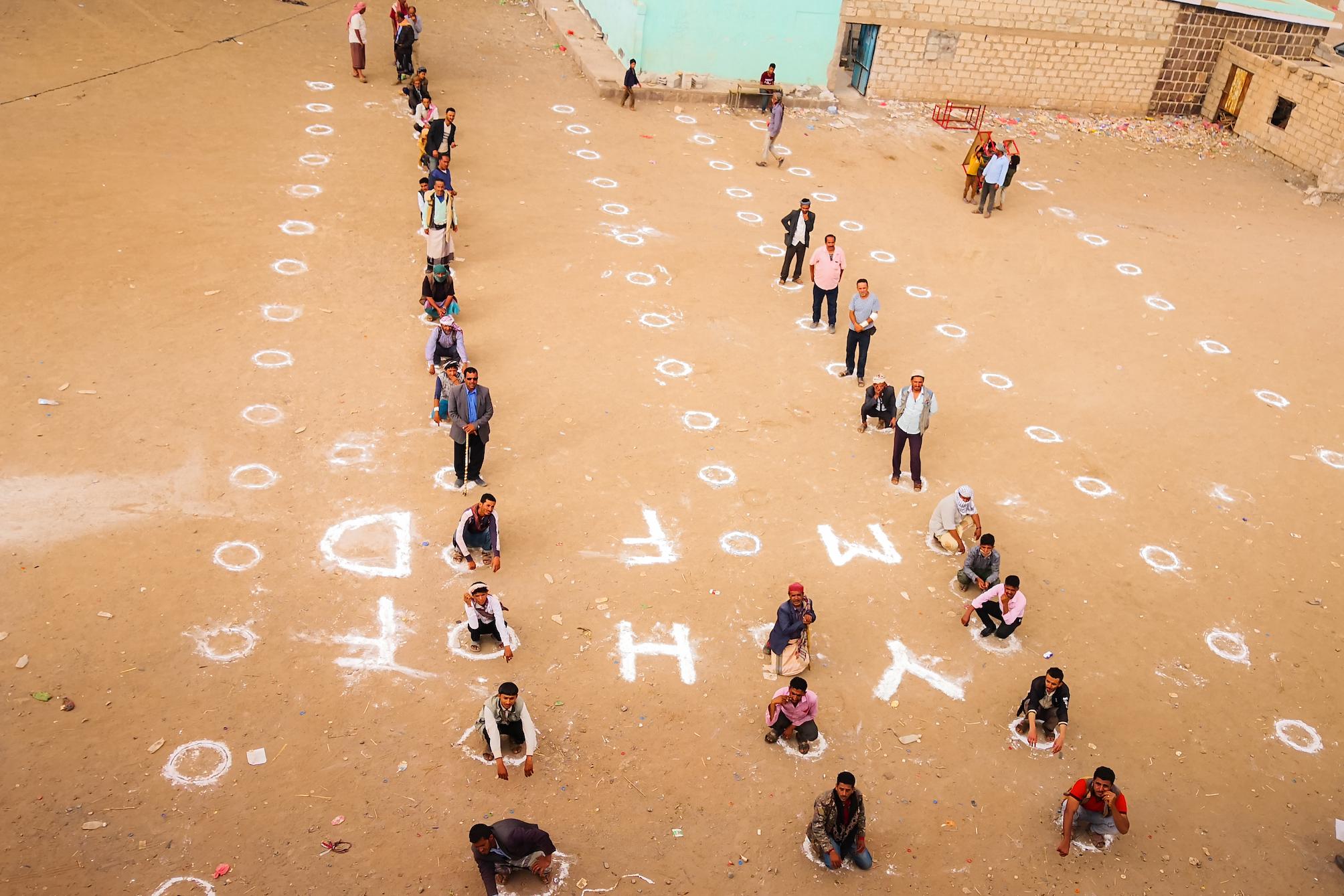- عربي
- 中文
- English
- Français
- Русский
- Español
World’s Most Vulnerable Countries Lack the Capacity to Respond to a Global Pandemic Credit: MFD/Elyas Alwazir
yemen_mfdelyas_alwazir_ocha.jpg

From Afghanistan to Trinidad and Tobago and many others, borders have shut, national emergencies have been declared and restrictions in the movement of people and goods are being enforced. By their very nature, these three groups of 91 countries are particularly vulnerable to external shocks given their limited means to respond.
The pandemic threatens to impact the LDCs, LLDCs and SIDS disproportionately with potentially devastating impacts on human health, including through social and economic effects of the virus and containment policies through the months and years to come. The lack of domestic financial resources, high debt levels and fragile health systems presents an urgent challenge. What has emerged as a health crisis in the short term may well have far reaching impacts on education, human rights, food security and economic development in the long term.
The pandemic is also having a dramatic effect on global migration and tourism. Remittances comprise important revenue for most LDCs, LLDCs, and SIDS, which overall provides more funds than Official Development Assistance.
As the trade impacts of the pandemic are emerging, an estimated $50 billion drop in global exports in February 2020 alone, this has the potential to impact severely the ability of vulnerable countries to access what are increasingly precarious international markets. LDCs for instance, account for less than 2 percent of world GDP and about 1 percent of global trade in goods. LLDCs are highly dependent on international trade and in particular, on commodities. A fall in commodity prices and reduction in demand for exports poses a balance of payment challenges and further marginalization of LLDCs in global trade. Due to their landlocked geographical location, restrictions on trade and cross-border transport may interrupt needed aid, medical equipment and basic goods flowing into LLDCs.
As advanced economies announce large-scale economic assistance and healthcare interventions, it is critical that the international community not neglect the fundamental responsibility to support those vulnerable members of the global family who have the least capacity to respond.
Supporting these vulnerable country groups will need a three-pronged approach to: (1) provide resources to stop the spread of COVID-19, (2) rapidly build capacity to curb the outbreak and (3) provision of resources to avoid economic collapse. Both financial and technical support will be necessary to limit the impact on the most vulnerable countries.
A statement by the High Representative for the Least Developed Countries, Landlocked Developing Countries and Small Island Developing States, Fekitamoeloa Katoa ‘Utoikamanu, stresses that to avoid a truly devastating global tragedy, in the days, weeks and months ahead, it will be critical that the international community urgently support vulnerable countries to strengthen their health systems and their capacity to halt transmission. In an ever more interconnected world, we are only as strong as our weakest health system.
For the latest case numbers around the world, visit the WHO COVID-19 Situation Dashboard and/or the Coronavirus Resource Center at Johns Hopkins University (JHU).
How is the United Nations responding to the pandemic?
The United Nations system through its global network of regional, sub-regional and country offices is supporting all governments and partners through the response and recovery of this crisis. The United Nations Secretary-General has established a dedicated COVID-19 Response and Recovery Fund to complement efforts in low and middle-income countries to address the socio-economic impact of the COVID-19 crisis.
The United Nations Secretary-General released a report on responding to the socio-economic impacts of COVID-19. The report is a call to action, for the immediate health response required to suppress transmission of the virus to end the pandemic and to focus on people – women, youth, low-wage workers, small and medium enterprises, the informal sector and on vulnerable groups who are already at risk.The report calls for enhanced international support, for countries with limited ability to fund expansionary stimulus, which has been further limited in recent days by currency instability. It also calls for debt relief for countriesat high risk of or in debt distress, especially LDCs and for new solutions to mobilize large injections of concessional finance – not only from multilateral development banks but also from private lenders such as pension funds, who will be in a hunt for low-growth investment opportunities.
The Secretary-General has also launched a Global Humanitarian Response Plan for COVID-19, a comprehensive inter-agency response plan that aggregates and up-dates relevant existing humanitarian appeals from UN and non-UN entities.
There are three main funds and appeals launched by the UN:
- Solidarity Response Fund: To address immediate health needs, WHO, UN Foundation and partners have launched a first-of-its-kind COVID-19 Solidarity Response Fund to raise money to address immediate health needs. The Fund supports the work of WHO and partners to help countries respond to the COVID-19 pandemic, raising over $150 million so far, as part of over $800 million WHO has raised in total.
- Humanitarian Appeal: To support the world’s most vulnerable countries, the UN launched a $2 billion coordinated global Humanitarian Response Plan to fight the impact of COVID in some of the world’s most vulnerable countries. It aims to protect millions of people and stop the virus from circling back around the globe. It brings together appeals and requirements from WHO, WFP, UNICEF, UNHCR, IOM, UNDP, UNFPA, UN-Habitat and NGOs, and identifies new needs. It is coordinated by UNOCHA and complements plans developed by the International Red Cross and Red Crescent Movement.
- Response and Recovery Trust Fund: To deliver rapid recovery, the UN Secretary-General established a COVID-19 Response and Recovery Trust Fund to support efforts in low and middle-income countries. It will enable the UN to provide a coordinated multi-agency, multi-sectoral response to national and local actions that address the socioeconomic impact of the COVID-19 crisis and enable rapid recovery.
How are the Least Developed Countries, Landlocked Developing Countries and Small Island Developing States being impacted?
Least Developed Countries
Health and Socio-Economic Impact
Least Developed Countries (LDCs) are facing both a health crisis and significant economic slow-down brought about by a collapse in commodity prices. These multi-faceted shocks interact in a complex manner and limit fiscal space to respond to the pandemic and to recover in a manner that does not leave the LDCs further behind.
The high prevalence of malaria, HIV/AIDS, tuberculosis and malnutrition adds additional burdens for LDCs, especially as the pandemic is likely to coincide with peak malaria season in 2020.
The pandemic is also impacting countries which are only just recovering from epidemics. After more than a year of battling an Ebola virus outbreak that killed more than 2,200 people, the UN is cautiously optimistic that the epidemic in the northeast Democratic Republic of the Congo (DRC) will soon be history as the country gears up to face the threat of COVID-19. As in other developing countries, COVID-19 will most likely divert the available national health capacity and resources, and leave millions of children affected by measles, malaria, polio and many other fatal diseases.
Not withstanding the health impacts of COVID-19, with commodity markets in turmoil, the pandemic presents a major economic crisis for LDCs. Oil, minerals, food and other commodities account for more than 70 per cent of the merchandise exports from LDCs.
Furthermore, the global demand and supply-side shocks arising from the impact of COVID-19, are also heavily impacting LDCs that are dependent on exporting manufactured goods, particularly clothing and apparel. Six LDCs – Bangladesh, Cambodia, Haiti, the Gambia, Nepal and Lesotho – receive more than 50 per cent of their export revenue from exporting manufactured goods. The contraction in exports will likely lead to current account deficits.
Remittances
The pandemic is likely to severely shrink remittance inflows as migrant workers face large scale job losses and are forced to return to their home countries. Remittances to LDCs are projected to fall by more than 20 per cent, representing a loss of a crucial financing lifeline for many vulnerable households.
Furthermore, many migrant workers have already lost their jobs without any compensation or unemployment benefits. COVID-19-related travel restrictions across the world are creating an unprecedented impact on labor mobility, new migration and remittances. A recent World Bank report says remittances to low and middle-income countries (LMICs) are projected to fall by 19.7 percent to $445 billion, representing a loss of a crucial financing lifeline for many vulnerable households.
Food Security
The pandemic is impacting food systems globally and pushing the world’s poorest and most vulnerable people toward greater food insecurity.
Hunger remains a major challenge and has further deteriorated as a result of COVID 19. Any decline in external demand will disproportionately hurt poor households employed in labor intensive manufacturing and agriculture sectors, which will further undermine their efforts to eradicate extreme poverty and achieve SDG 1.
LDCs are seeing a growing number of cases and include: Bangladesh, Afghanistan, Guinea, Djibouti and Burkina Faso.
Call to Action for LDCs
LDCs have called for stronger domestic measures and scaled-up international support to address the social and economic impact of COVID–19. This includes a call for a global stimulus package for LDCs to be implemented with immediate effect.
In the call for a global stimulus package for LDCs, countries have identified eight immediate short term measures:
- Emergency public health package for LDCs
- Support for social protection systems
- Education support for students
- 0.15 per cent of ODA to LDCs
- Full debt cancellation
- Lifting trade barriers and scaling up aid for trade
- Additional allocation including increased SDR allocation for LDCs
- Protect migrants of LDCs and promote their remittances
LDCs have also identified medium to long-term measures ranging from access to vaccines/immunization and antiviral drugs to stimulus packages to stabilize the agricultural sector supporting countries graduating from the category of LDCs with continued and scaled–up international assistance.
The full LDC statement can be found here.
Landlocked Developing Countries
Health and Socio-Economic Impact
The number of cases and deaths from COVID-19 are rising in Landlocked Developing Countries (LLDCs). As of 4 May 2020, more than 24,000 cases of COVID-19 have been reported in 30 of the 32 LLDCs, with confirmed deaths in 22 of them. European and Central Asian LLDCs are the most impacted in terms of COVID-19 cases and deaths.
The health systems of LLDCs are among the weakest in the world and they are also critically dependent on imported medical and pharmaceutical products. A 2016 analysis ranked 195 countries for their vulnerability to infectious disease. Fifty percent of the LLDCs are in the top 50 countries estimated to be most vulnerable to infectious disease.
Transport and Trade Impacts
LLDCs are being impacted, among other things, by declines in commodity prices, challenges in transit, loss of export revenue, investment and remittances along with plummeting tourism, with long-term ripple effects.
LLDCs are particularly vulnerable to cross-border restrictions and border closures, given their dependency on transit transport to access international markets. Due to COVID-19 related dramatic supply and demand shocks in the world economy the LLDCs face a relatively huge loss of foreign exchange earnings. Losses in export earnings will be compounded by the sharp decline in commodity prices, which is estimated to be 37 per cent this year according to UNCTAD.
The International Transport Forum projected that global freight transport (outside of cities) would fall by 36% in 2020 compared to estimates foreseen without COVID-19. WTO estimated that world merchandise trade is expected to plummet by between 13 per cent and 32 per cent in 2020 depending on the depth and extent of the global economic downturn.
Due to LLDCs geographical location and their reliance on transit countries for exports and import of goods, restrictive measures at borders aimed at curtailing the spread of COVID-19 will greatly affect movement of goods to and from LLDCs.
The LLDCs’ losses in export earnings will be compounded by the sharp decline in commodity prices, which is estimated to be 37 per cent this year according to UNCTAD. The limited diversification of economic activity in many LLDCs, with 26 of them being commodity-dependent when it comes to their exports, leaves them more vulnerable than ever to these new shocks and disturbances.
UNCTAD has estimated that the economic impact of COVID-19 could put downward pressure on FDI flows in a range of -30% to -40% during 2020-2021. The World Bank estimated that remittances to low and middle-income countries (LMICs) are projected to fall by 19.7% in 2020, representing a loss of a crucial financing lifeline for many vulnerable households in LLDCs. several countries with high percentage of remittances to GDP, including Kyrgyzstan (29.2%), Lesotho (21.3%), Nepal (27.3%), South Sudan (34.4%), Tajikistan (28.2%) are particularly vulnerable.
Call to Action for LLDCs
In a joint statement issued by Ambassadors of Landlocked Developing Countries at the United Nations, the group stress that if the impact of COVID-19 is not prevented or mitigated, it could have the effect of reversing the gains that have been made by the LLDCs on the SDGs and the LLDCs might be left behind.
The statement calls on LLDCs and transit countries to keep cross-border transport networks for goods and supply chains open, while protecting the safety of transport workers and citizens, to maintain the integration of LLDCs into world trade and ensure that critical goods and medical supplies needed to contain and combat the pandemic can reach LLDCs in a timely manner.
The call for action seeks support on six key points:
- Support LLDCs to prepare and respond to the impact of COVID-19
- Lift restrictions on the import of medical supplies by LLDCs
- Ensure supply of vaccines and relevant drugs when they are developed
- Provide technology to manufacture anti-retroviral drugs and vaccines
- Support LLDCs with medical personnel or capacity building
- Immediately open virtual Tele-health and Telemedicine Vendors
The full LLDC statement can be found here.
Small Island Developing States
Health and Socio-Economic Impact
SIDS are highly vulnerable to the impacts of COVID-19 both to the potentially devastating impacts on human health and to the broader social and economic effects of the virus and containment policies. According to a recent policy brief by the United Nations Department of Economic and Social Affairs, the reported number of COVID-19 related deaths per 100,000 people is higher in these countries compared to other developing country groups and regions, including LDCs and LLDCs. As of 1st of May 2020, Bahamas, Dominican Republic and Trinidad and Tobago, are experiencing mortality rates as high as hard hit European countries.
SIDS economies are also small and vulnerable to external shocks, and many struggle already with high debt burdens. The external debt of SIDS as a group accounts for 72.4% of their GDP on average, reaching up to 200% in the Seychelles and the Bahamas according to UNCTAD.
Furthermore, many rely on tourism for large shares of their income or remittances from other economies that are now in lock down. SIDS face substantial challenges across sustainable development resulting from the pandemic and related policy responses around the world. Urgent support, including financial, technical and material, is needed from the international community.
Tourism Impacts
The measures put in place to contain the spread of the pandemic have taken a heavy toll on the tourism sector. The United Nations World Tourism Organization (UNWTO) estimates that COVID-19 will result in a contraction of the tourism sector by 20% to 30% in 2020.
SIDS are especially dependent on the tourism sector. For example, in Seychelles in 2018, tourism contributed an estimated 67% to its GDP as well as indirectly and directly hired 67% of the workforce (WTTC 2018).
Overall, travel and tourism in SIDS is worth some $30 billion per year. According to UNCTAD, a decline in tourism receipts by 25% will result in a $7.4 billion or 7.3% fall in GDP. The drop could be significantly greater in some of the SIDS, reaching 16% in the Maldives and Seychelles.
Call to Action
In a statement released by the Alliance of Small Island States (AOSIS), island nations are calling for the support of the international community and noting that the level of fiscal measures required to preserve whatever development gains SIDS made before the start of 2020 is now out of reach.
Among the support measures SIDS are calling for include urging the World Bank, IMF, regional development banks and commercial lenders to identify fiscal response measures that are innovative and of a different order of magnitude. SIDS are also calling for reviving the global momentum for implementation of the Paris Agreement and the 2030 Agenda for Sustainable Development.
The full SIDS statement can be found here.





